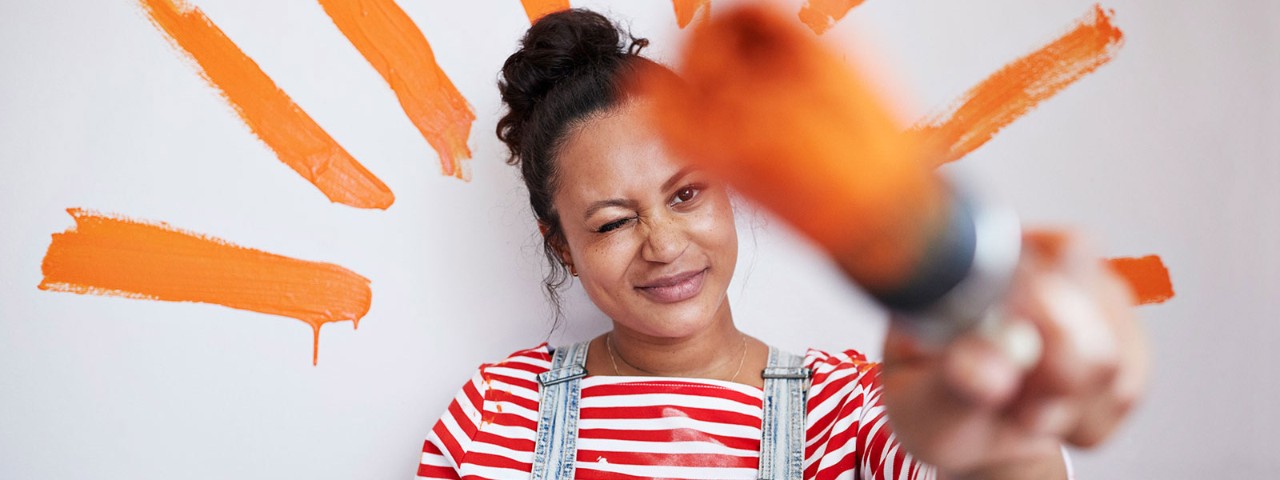Check out our guide for how to celebrate the year that was and look forward to the year that will be across Melbourne and regional Victoria this New Year’s Eve.
The art of boosting mental health

More than something nice to look at, art can play a powerful role in promoting our emotional wellbeing.
Whether you choose to take up a paintbrush or wander through a gallery, art can help protect and improve mental health, both for individuals and the community.
Scientific studies have revealed that simply visiting a gallery can have a positive impact on wellbeing and mental health – and can even mimic the feeling of falling in love.
Professor Semir Zeki, a neurobiologist with the University of London, scanned the brains of volunteers viewing art and discovered that when a person finds an artwork beautiful, it triggers the release of dopamine in the brain, the chemical related to feelings of love, pleasure and desire.
RACV’s head of visual arts Mardi Nowak says as well as evoking feelings of joy and wellbeing, art can also play a powerful role in boosting mental health by bringing people together to create connections and start conversations.
“At RACV, we value the role art plays in connecting communities, and how through its reach, it can foster social cohesion across all ages, backgrounds and cultures. Art enriches civic engagement, connects communities and creates valuable social impact.”
She says art plays a key role in RACV’s efforts to support mental health in Victoria's regional communities. To this end, RACV has formed a three-year partnership with arts incubator MPavilion to encourage connections and conversations around art in the regions.
Currently RACV has loaned 20 pieces from its collection of Australian contemporary art to the Benella Art Gallery as part of an exhibition, Re-gathering, which examines the local community's collective experience of COVID-19.
The curators involved the Benalla community in planning the exhibition by inviting locals to share their experiences of life in lockdown – what they missed, what they rediscovered, what they learned about themselves. The responses then helped inform the selection of artworks for the exhibition and were also incorporated as text into a screen-based work that forms a centrepiece of the exhibition. And recently the responses were also explored at a panel discussion hosted at the gallery in partnership with MPavilion and led by Mardi (see video above).
Mardi says in these community conversations, the “art of doing” emerged as a positive theme in helping to protect and preserve mental health.
“In lockdown, there was a flurry of crafty, creative pursuits,” she says. “People created art to cope with stressful and difficult situations. Using their hands switched their brains to a different space and allowed them to be mindful and self-aware.”
People realised they didn’t have to be an established artist to create art and were rewarded with a sense of achievement for what they created, says Mardi.
And importantly, creating art also presented an outlet for difficult emotions.
“Creative work allows you to show your feelings if you can’t talk about them, but you may not wish to share it with anyone and that’s okay too.”
But the benefits of creating and viewing art extend beyond the individual to enhance social cohesion across the broader community, explains Mardi. For example, an artwork depicting last year’s bushfires may touch some viewers who experienced the fires first-hand while also allowing those who didn’t experience the fires to get an understanding of what it was like.
This is especially so in regional Victoria, where art can play an important role in connecting people in sometimes isolated communities, says Annie Rowland, of the Live4Life program, which works with regional communities to improve youth mental health and prevent youth suicide.
“Public galleries offer accessible points of connection to people, encouraging people to come together, to explore together, to co-create, and are an invitation to think and feel,” says Annie, who was one of the panellists speaking at the recent Benalla Gallery discussion.
“They offer opportunities for communities to work collectively on projects, building and strengthening relationships between individuals and between individuals and their communities.”
This in turn can help shape community identity and engage people in conversations and learning opportunities, she says.
Such opportunities can benefit individuals on many levels, explains Annie, such as increasing their practical skillset and helping to develop identity and positive self-esteem.
She says both the creation and appreciation of art provides time out, a mindfulness or escape from the stress of daily life.
“Art provides a way of connecting to our communities, to ourselves and to our feelings and being able to express them. Put all that together, and art is a way of protecting and preserving a sense of wellbeing,” she says.
The Re-gathering exhibition is on until 20 June, 2021 at the Benalla Art Gallery, 97 Bridge Street, Benalla.




